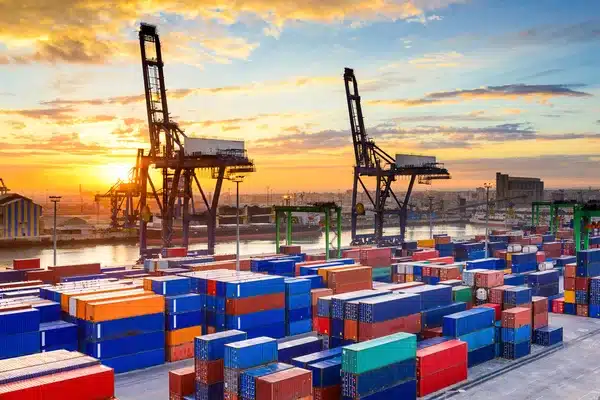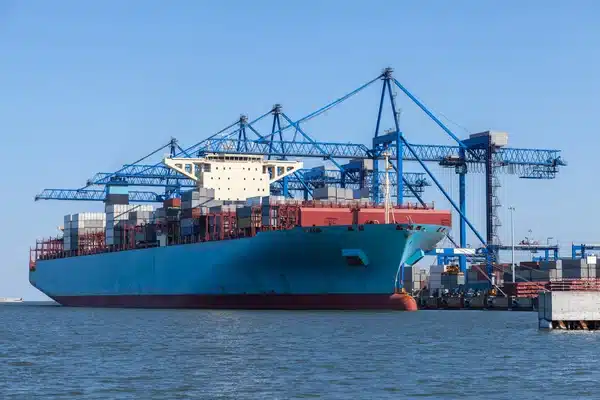International shipping is an intricate world filled with specialized jargon and industry-specific terms. Understanding these terms is crucial for anyone involved in the shipping industry, whether you are an importer, exporter, or working in logistics. Knowing the terminology helps streamline communications, avoid misunderstandings, and improve the efficiency of your supply chain. In this article, we’ll explore 15 of the most common terms used in international shipping, breaking down what they mean and why they are important for your business.

Table of Contents
1. Gross Weight (VGM)
Definition: Gross Weight, also known as Verified Gross Mass (VGM), refers to the total weight of a shipping container, including the cargo and the container itself. This measurement is required under the International Maritime Organization’s SOLAS (Safety of Life at Sea) regulations.
Why It Matters: Gross weight is crucial for vessel stability and safety. Accurate reporting of VGM helps prevent accidents caused by overloading and ensures compliance with international maritime safety standards. Incorrect weight declarations can lead to hefty fines, cargo being denied loading, or even vessel instability, which can endanger the crew and cargo.
Practical Application: To determine VGM, shippers must either weigh the loaded container or add the weight of the cargo to the container’s tare weight. Accurate measurements help ensur
2. Bill of Lading (B/L)
Definition: A Bill of Lading (B/L) is a legal document issued by a carrier to a shipper, providing details of the cargo being transported, acting as a receipt, and serving as a contract of carriage.
Why It Matters: The Bill of Lading is fundamental for customs clearance, transfer of ownership, and serves as proof of shipment. It is a key document in both sea and air freight, and any discrepancy can lead to delays or legal complications.
Types of Bill of Lading: There are different types of Bills of Lading, including Straight B/L, Order B/L, and Bearer B/L. Each serves different purposes, such as specifying the consignee or allowing cargo transfer without endorsement. Understanding these types helps avoid complications during transactions.
3. Less than Truckload (LTL) Charging
Definition: Less than Truckload (LTL) refers to a shipment that does not require a full truck for transportation and is consolidated with other shipments to maximize efficiency.
Why It Matters: LTL is an ideal solution for smaller shipments. It helps to reduce costs for shippers by sharing truck space with other cargo. However, it also involves additional handling, which can increase transit times and the risk of damage.
Cost Considerations: LTL shipments are generally priced based on factors such as distance, weight, dimensions, and freight class. Proper packaging is essential to protect your goods, as LTL shipments may be loaded and unloaded multiple times during transit.
4. Door-to-Door (D2D)
Definition: Door-to-Door (D2D) is a shipping service where goods are picked up from the supplier’s location and delivered directly to the buyer’s specified address, covering every leg of the journey.
Why It Matters: D2D provides convenience by offering a complete shipping solution. It is particularly beneficial for importers who want a hassle-free experience without managing multiple carriers and customs brokers. D2D services also minimize the risk of cargo theft and handling errors, as fewer intermediaries are involved.
When to Use: D2D services are especially useful for e-commerce businesses, high-value goods, or items that require careful handling. Working with a trusted logistics partner ensures transparency and reliability in the process.
5. Harmonized System (HS) Code
Definition: The Harmonized System (HS) Code is an internationally standardized system of names and numbers used to classify traded goods, maintained by the World Customs Organization (WCO).
Why It Matters: HS Codes determine tariffs, duties, and regulations for specific goods. Accurate classification is crucial for avoiding customs delays, ensuring compliance, and accurately calculating duties. Incorrect HS codes can lead to shipment reclassification, fines, or customs seizures.
How to Use: HS Codes consist of 6-10 digits that specify the type of goods. For instance, electronics may fall under a different HS code compared to textiles. Consulting a customs broker can help ensure you use the correct HS code and minimize risks during customs clearance.
6. Container Freight Station (CFS)
Definition: A Container Freight Station (CFS) is a facility where LCL (Less than Container Load) shipments are consolidated or deconsolidated before or after containerization.
Why It Matters: CFS helps in handling smaller shipments efficiently by consolidating goods into containers for export or deconsolidating upon arrival. It allows shippers to benefit from lower costs without needing an entire container.
Importance in LCL Shipping: CFS facilities also help manage paperwork and customs formalities, making it easier for smaller shippers to access international markets. However, due to multiple cargo handling, CFS shipments may have longer transit times.

7. Peer-to-Peer (P2P) Parcel Delivery Service
Definition: Peer-to-Peer (P2P) Parcel Delivery Service is a shipping method that connects individual couriers with shippers directly, often through online platforms, allowing for fast and cost-effective delivery.
Why It Matters: P2P services provide flexible and often cost-effective options, particularly for small parcels. This method is suitable for businesses needing quick delivery without relying on traditional courier networks. P2P can also lead to more personalized customer service.
Examples: Platforms like Uber Freight and Roadie allow businesses to access independent couriers. This model is ideal for companies needing flexibility and direct contact with drivers for real-time tracking.
8. Full Container Load (FCL)
Definition: Full Container Load (FCL) refers to a shipping option where the entire container is used by a single shipper, allowing exclusive use of the container.
Why It Matters: FCL is often more economical for large shipments, provides better security for the cargo, and involves less handling compared to LCL, minimizing the risk of damage. It also allows for faster transit times since the container does not require consolidation or deconsolidation.
Cost Efficiency: FCL is best for businesses shipping high volumes that can fill an entire container. It reduces per-unit costs and minimizes the potential for delays and damage.
9. Less than Container Load (LCL)
Definition: Less than Container Load (LCL) is a shipping option where multiple shipments are consolidated into a single container, making it ideal for smaller consignments.
Why It Matters: LCL is cost-effective for smaller shipments, although it may involve more handling and longer transit times compared to FCL. It allows companies without full container volumes to benefit from global shipping.
Considerations: LCL requires careful packaging to protect goods from damage due to frequent handling. It is crucial to work with a reliable freight forwarder who can provide transparency and avoid unnecessary delays.
10. Certificate of Origin (COO)
Definition: A Certificate of Origin (COO) is a document certifying the country where the goods were manufactured or produced.
Why It Matters: Many countries require a COO for determining tariff rates and verifying compliance with trade agreements, enabling shippers to benefit from preferential tariffs under specific Free Trade Agreements (FTAs).
How to Obtain: COOs are typically issued by the chamber of commerce or another authorized entity. They provide critical information for customs authorities to determine duties and eligibility for special trade programs.
11. Estimated Time of Departure (ETD)
Definition: Estimated Time of Departure (ETD) refers to the projected date and time when a shipment is expected to leave the port of origin.
Why It Matters: ETD is crucial for planning the logistics timeline, coordinating schedules with suppliers, and managing customer expectations regarding delivery times. Accurate ETD information helps ensure smooth scheduling of downstream activities, such as warehousing and distribution.
Managing Delays: ETD may change due to factors such as port congestion or vessel availability. It is important to maintain communication with carriers for updates to avoid disruptions in your supply chain.
12. Estimated Time of Arrival (ETA)
Definition: Estimated Time of Arrival (ETA) is the estimated date and time when a shipment will arrive at its destination port or delivery location.
Why It Matters: ETA helps in managing expectations, planning unloading activities, and coordinating final delivery. Accurate ETA information helps businesses in effectively scheduling inventory and labor, avoiding unnecessary storage fees or labor costs.
Tracking Tools: Modern logistics providers offer tracking tools that provide real-time updates on ETA, allowing companies to make informed decisions on inventory and workforce planning.
13. Port of Loading (POL)
Definition: The Port of Loading (POL) is the port where the goods are loaded onto the vessel for international shipment. It serves as the starting point for the cargo’s sea journey and plays a critical role in the logistics chain.
Why It Matters: The choice of POL is a key factor in determining shipping schedules, overall costs, and logistics efficiency. Selecting a well-connected POL with frequent sailings can significantly reduce transit times and costs. A major POL typically has better infrastructure and more shipping line options, which results in quicker handling and fewer delays. Additionally, the proximity of the POL to the supplier’s location impacts inland transportation costs, affecting the total shipping cost. Choosing the optimal POL helps ensure smooth and efficient cargo movement throughout the supply chain.
Considerations: When selecting a POL, factors such as availability of shipping lines, frequency of sailings, and connectivity to major trade routes should be considered. Ports like Shanghai, Shenzhen, and Ningbo in China are popular due to their high connectivity and infrastructure, making them suitable choices for many shippers.

14. General Rate Increase (GRI)
Definition: General Rate Increase (GRI) is an adjustment made by shipping carriers to base freight rates. It is often implemented during periods of high demand, such as peak seasons, or in response to changing market conditions, like increased fuel costs or port congestion.
Why It Matters: GRIs directly impact the cost of shipping, making it essential for shippers to understand when these increases are likely to occur. By being proactive and aware of upcoming GRIs, businesses can plan their shipments more effectively and potentially avoid higher costs. Strategies such as booking shipments during off-peak times or negotiating fixed rates with carriers in advance can help mitigate the financial impact of a GRI. For many businesses, understanding and anticipating GRIs is critical to maintaining competitive shipping costs and avoiding disruptions to their logistics budgets.
Managing GRI: Companies can mitigate the impact of GRIs by building strong relationships with carriers or freight forwarders who have insight into market trends. Additionally, considering alternative shipping routes or consolidating shipments during peak seasons can help reduce exposure to sudden cost increases due to GRIs.
15. US Commodity Code (HTS Code)
Definition: The US Harmonized Tariff Schedule (HTS) Code is a classification system used for identifying products imported into the United States. It is similar to HS Codes but provides additional specificity tailored to US regulations.
Why It Matters: Proper classification using the HTS Code is crucial for determining applicable tariffs, duties, and ensuring compliance with US customs regulations. Misclassification can lead to costly fines, shipment delays, or even seizure of goods by customs authorities. Accurate HTS classification helps businesses predict import costs accurately and avoid unexpected issues during customs clearance.
Practical Use: HTS Codes are typically required when filing entry summaries with US Customs and Border Protection (CBP). Businesses should ensure that they work with experienced customs brokers to classify their goods correctly, thereby reducing the risk of penalties.
Learn more:
if sold in Amazon USA
Conclusion
Understanding these 15 common international shipping terms is key to navigating the complexities of global logistics effectively. Each term plays a vital role in streamlining communication, ensuring compliance, and managing expectations within the supply chain. Whether you’re a seasoned professional or just starting out, familiarity with these terms will enhance your ability to make informed decisions, minimize costs, and prevent misunderstandings. Effective knowledge of these shipping terms can help you negotiate better contracts, ensure compliance, and ultimately streamline your entire shipping process. If you need expert support for your international shipping needs, contact our logistics team today for tailored assistance and solutions.


